Common Hardware Failures and Repair Techniques in IoT Development
- latest articles
- 1.DApp Development & Customization: Merging Diverse Market Needs with User Experience 2.Analysis of the Core Technical System in DApp Project Development 3.How to achieve cross-chain interoperability in Web3 projects? 4.How does the tokenization of points reconstruct the e-commerce ecosystem? 5.How to Set and Track Data Metrics for a Points Mall? 6.What is DApp Development? Core Concepts and Technical Analysis 7.Inventory of commonly used Web3 development tools and usage tips 8.Development of a Distribution System Integrated with Social E-commerce 9.Six Key Steps for Businesses to Build a Points Mall System 10.What is DApp Development? A Comprehensive Guide from Concept to Implementation
- Popular Articles
- 1.Future Trends and Technology Predictions for APP Development in 2025 2.Analysis of the DeFi Ecosystem: How Developers Can Participate in Decentralized Finance Innovation 3.From Zero to One: How PI Mall Revolutionizes the Traditional E-commerce Model 4.DAPP Development | Best Practices for Professional Customization and Rapid Launch 5.How to Develop a Successful Douyin Mini Program: Technical Architecture and Best Practices 6.Recommended by the Web3 developer community: the most noteworthy forums and resources 7.From Cloud Computing to Computing Power Leasing: Building a Flexible and Scalable Computing Resource Platform 8.Shared Bike System APP: The Convenient Choice in the Era of Smart Travel 9.How to Create a Successful Dating App: From Needs Analysis to User Experience Design 10.From Design to Development: The Complete Process of Bringing an APP Idea to Life
The Internet of Things (IoT), as a cutting-edge field of modern technology, has deeply penetrated various industries. Whether in smart homes, industrial automation, or smart healthcare, IoT plays an increasingly important role. However, during the development and application of IoT devices, hardware failures often pose challenges for developers and engineers. This article will provide a detailed discussion on the common types of IoT hardware failures, their causes, and repair techniques, aiming to help developers improve the efficiency of fault diagnosis and resolution, ensuring the stability and reliability of IoT systems.
I. Common Types of IoT Hardware Failures
IoT devices consist of multiple hardware components, including sensors, actuators, controllers, communication modules, and power supply modules. These hardware components may experience various failures during operation. Common types of hardware failures include:
Power Supply Failures
Power supply failures are one of the most common issues in IoT hardware, especially in battery-powered devices. Insufficient battery power or poor power line connections can prevent the device from starting or operating normally.
Common Symptoms:
Device fails to power on.
Device shuts down automatically after running for a period.
Device flickers or restarts irregularly.
Cause Analysis:
Insufficient battery power, not charged or replaced in time.
Unstable power supply voltage, leading to insufficient power.
Loose or poor power connection.
Sensor Failures
In IoT devices, sensors are used to collect environmental data (such as temperature, humidity, air pressure, etc.). Their failures can directly affect the device's performance and data accuracy.
Common Symptoms:
Sensor fails to respond to input signals or collect data.
Sensor outputs abnormal data.
Sensor sensitivity decreases, unable to detect minor changes.
Cause Analysis:
Sensor aging or damage.
Poor connection between the sensor and other components.
Unsuitable environmental conditions (e.g., excessively high or low temperature, humidity).
Communication Module Failures
IoT devices typically rely on communication modules (such as Wi-Fi, Bluetooth, Zigbee, etc.) for data transmission. Communication failures may prevent the device from effectively exchanging data with other devices or cloud platforms.
Common Symptoms:
Device fails to connect to the network or disconnects.
Data transmission is interrupted or lost.
Device cannot discover other devices.
Cause Analysis:
Signal interference affecting wireless communication quality.
Wireless module failure or damage.
Incorrect network configuration or unstable network.
Actuator Failures
Actuators are used to perform physical operations based on sensor inputs or commands, such as motors and valves. Actuator failures may prevent the device from completing scheduled tasks.
Common Symptoms:
Actuator fails to move.
Actuator movement is inaccurate or sluggish.
Actuator produces excessive noise.
Cause Analysis:
Actuator circuit failure.
Actuator mechanical part jammed or damaged.
Insufficient drive voltage or excessive current causing overheating.
Board Failures
In complex IoT devices, the circuit board is the core of the system. Board failures can prevent the device from starting or cause partial functionality to fail.
Common Symptoms:
Device completely fails to start.
Partial functions do not work properly.
Visible damage on the board surface, such as burn marks.
Cause Analysis:
Short circuit or open circuit on the circuit board.
Poor soldering or damage to board components.
Current overload causing component overheating and damage.
II. Analysis of Hardware Failure Causes
Hardware failures can be attributed to multiple factors. Below are some common causes:
Environmental Factors
Most IoT devices operate in real-world environments, and unsuitable environmental conditions can lead to hardware failures. For example, excessively high temperatures, humidity, dust, corrosive gases, etc., can affect hardware performance. Sensors and actuators deployed outdoors, in particular, are more prone to failure due to prolonged exposure to harsh conditions.
Power Supply Issues
Power supply issues are a common root cause of hardware failures, especially in battery-powered devices. Problems such as insufficient battery power, delayed charging, and unstable supply voltage can prevent devices from functioning properly.
Hardware Design Defects
Improper design or inappropriate component selection during the hardware design process can also lead to failures. For instance, circuit designs with overload risks, signal interference, or improper component selection can cause device malfunctions.
Aging and Wear
Over time, many hardware components in IoT devices gradually age or wear out, leading to performance degradation or failure. Common aging issues include battery deterioration, reduced sensor sensitivity, and loose solder joints on circuit boards.
Human Factors
Operational errors by development and maintenance personnel, such as incorrect wiring, improper component installation, or poor soldering, can also cause hardware failures.
III. Hardware Failure Repair Techniques
When IoT hardware fails, repair is a critical step to ensure system functionality. Below are some common hardware failure repair techniques:
Power Supply Failure Repair
For power supply failures, first check the battery level to ensure it is sufficiently charged. If the battery is damaged, replace it promptly. For devices using external power, check the stability of the power adapter, plug, and cable connections. If the power supply voltage is unstable, use a regulated power supply or replace the power module.
Sensor Failure Repair
When a sensor fails, first check if its power and signal lines are functioning properly. If the sensor is damaged, consider replacing it. Calibrate the sensor and ensure its connection with other components is secure. Additionally, regularly clean the sensor surface to prevent dust and debris from affecting its performance.
Communication Module Failure Repair
For communication failures, first check if the communication module's power supply is normal. Then, verify the stability of its connection with other devices. If the wireless module is faulty, try replacing the antenna or selecting a wireless channel with less interference. For network configuration, ensure settings such as IP address, subnet mask, and gateway are correct.
Actuator Failure Repair
For actuator failures, first check if the power voltage is normal, then confirm if the drive signal is correct. If the actuator fails to move, it may be due to motor jamming or drive circuit failure. In such cases, disassemble the actuator for inspection and replace damaged parts if necessary.
Circuit Board Failure Repair
Circuit board failures are more complex issues and typically require testing with tools like multimeters and oscilloscopes. Check for short circuits, open circuits, or burn marks on the board. For poorly soldered components, re-solder them. If components are damaged, replace them accordingly.
IV. Measures to Prevent Hardware Failures
Preventing hardware failures is more important than repairing them afterward. Below are some preventive measures:
Select Hardware Appropriately
When designing IoT devices, choose suitable hardware based on actual needs to avoid over-engineering or using unreliable components.
Optimize Power Management
Adopt efficient and stable power management solutions, regularly check battery levels, and prevent device downtime caused by battery aging or power supply failures.
Anti-Interference Design
For wireless communication modules, design circuits with strong anti-interference capabilities, select appropriate wireless frequency bands, and enhance signal processing to avoid communication failures caused by signal interference.
Regular Maintenance and Inspection
IoT devices require regular inspection and maintenance to check the performance of sensors, actuators, batteries, and other components, replacing damaged parts in a timely manner.
V. Conclusion
Hardware failures in IoT are an inevitable part of device operation, and timely fault diagnosis and repair are crucial for ensuring system stability. Through proper hardware design, preventive measures, and effective repair techniques, the occurrence of hardware failures can be significantly reduced, enhancing the reliability of IoT systems. In the future, as IoT technology continues to advance, hardware failure repair and management will become increasingly intelligent, providing developers with more convenience and support.
-

How to Use IoT Development to Enhance Supply Chain Efficiency
With the rapid development of the global economy and the deepening of digital tr···
-

Development and Innovation of the Internet of Things in the Healthcare Sector
With the rapid advancement of information technology, the Internet of Things (Io···
-

Data Storage and Analysis Methods in IoT Development
The Internet of Things (IoT) is one of the most revolutionary innovations in tod···

 Blockchain
Blockchain












